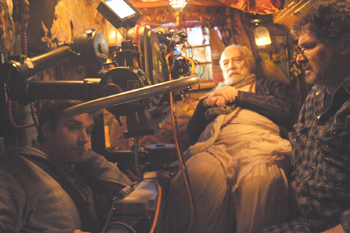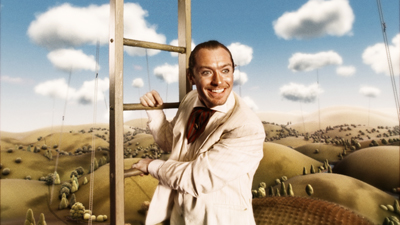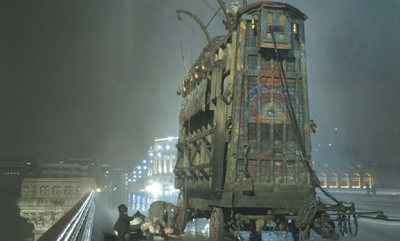|
THE TERRY GILLIAM FILES // "IMAGINARIUM" (2009) |
Cinematographer Nicola PecoriniOn Shooting
|
 |
|
What were some of the stylistic or technical challenges you faced on this film that differed from those you faced on FEAR AND LOATHING, TIDELAND and BROTHERS GRIMM? Pecorini: FEAR AND LOATHING was a trip, actually various trips into different hallucinations, but that's a distorted reality that still has to maintain strong, real roots. GRIMM was supposed to be scary, [and] to be scared you must think that it's possible, therefore realistic. In TIDELAND we had only a few scenes that were totally fantastic, with this movie we took a further step into it, PARNASSUS is half-real, half-pure imagination, dreamlike. It does not necessarily need to be "realistic." The challenge was to manage to give form to dreams, where different elements — some real, others totally unrealistic — come together and leave you with a specific mood, a state of mind. And each mind is different by definition. It was actually great fun, like Monique with her costumes, we were free to pick from total different styles, ages, landscapes, color palettes. Given the technicality of the shoot (the mixing of real life, models and CG elements), it was important to be consistent in following the guidelines we embraced, especially regarding light sources and colors. What were your conversations with Terry/the designers like about the influences of specific artists on the Imaginarium scenes (Grant Wood, Maxfield Parrish, etc), and what of your own style or inspirations did you bring to the film's look? Pecorni: With Terry and Dave Warren we went on for months exchanging pictures, Web addresses, sketches, and at the end we established some specific looks for the different Imaginariums. Odd Nerdrum became the main reference for the Parnassus-guided landscape. Nerdrum is a Norwegian artist that we discovered around the time of THE BROTHERS GRIMM, and we have been pretty obsessed by it since. The height and depth of those vistas is what we were looking for.
Maxfield Parrish was also just perfect for that kind of Imaginarium, just the right amount of kitsch! Another person who really helped us out in finalizing our choices was Daniel Auber, a good friend who had already worked with Terry on BROTHERS GRIMM. He's a fantastic artist and he visualized Terry's vision of the "Louis Vuitton Shoe Paradise" scene, the "Dr. Seuss world," and the Maxfield Parrish moments. He took pictures of the actual shoes (Jerome C. Rousseau's 2008 collection) that were then used as models for the CG build. VSFX were involved very early on. We needed to know exactly what we were going to do, and as always on Terry's movies where everybody is encouraged and feels entitled to have a say, both Richard Bain and Paul Docherty ended up having creative inputs as well. The film does not pretend to be naturalistic, either in the Imaginarium scenes or in the "normal" scenes — what specific lighting schemes/camera set-ups/lenses were used to accentuate that non-naturalism? Pecorini: It certainly does not want to be naturalistic on the other side of the mirror, but the contemporary London is as naturalistic as it could be — it's just a different London from what we usually see in the news or in the movies. It's gritty, full of contrasts, full of contradictions. Terry has been living in London for 40 years now and he had lots of locations in his mind. Some were not affordable, others were simply unavailable (we shot around Christmas 2007, it was also very difficult to avoid too many season decorations), and we ended up using every possible corner of the Battersea Power Station — avoiding showing the trademark chimneys though, an abused image. [other locations included Borough Market and the Cathedral, an obscure parking lot next to High Barnet, Leadenhall Market, Clerkenwell, the City at night, and Blackfriars Bridge. Lens wise it was quite funny, because at the beginning Terry was adamant about restraining ourselves in the use of wide angle lenses on this side of the mirror, to then stay as wide as possible once in the Imaginarium. We lasted 2 set-ups. On the 3rd one, the 14mm went back on, and it rarely left the camera! (The camera crew refered to the 14mm as The Gilliam.) It is true though that in London we always shot with at least 2 cameras. Given the tight schedule we needed to grab as much footage as possible. Generally we had a Steadicam or dolly master, and a B camera fishing whatever possible, using 32mm or 40mm lenses. And those are very long lenses in our language — I believe that on a couple of occasions we even used a 65mm. What in-camera effects were employed as opposed to optical/CG? Pecorni: The main resource we used were models — good, old style, handmade brilliant models that we shot at Bray Studios at the very end of the schedule. But also much "cheaper" solutions. For the mirror, for example, at the beginning we thought of lots of difficult, complicated, sophisticated and expensive solutions, to then settle for plain Mylarę, a mirror-like plastic sheet that has been used theatrically for quite some time. At the beginning we worried about seeing ourselves, or not being "magical" enough, but once we started we found that all we needed to do was to cut completely the light right behind the mirror to have our heroes disappearing immediately. There were also other "cheap" solutions; like the first time we enter the mirror with the drunk and we find ourselves in a bi-dimensional forest. That idea has been in Terry's mind for quite some time, and realizing a real flat forest was certainly more effective and cheaper than creating a CG one from scratch. What were some of the difficulties you faced shooting on the streets of London, in/around the wagon and on locations?
The Wagon itself was completely self-contained in terms of lighting. The practicals were the only lights, and I balanced all my lighting to pre-existing public street lighting. My rigging crew spent a lot of time making sure that every public light available was working! As an example: we had two days to shoot the whole sequence of the "revamped" Imaginarium, something like 18 pages! At the beginning it was meant to be Bond Street, but luckily the budget wouldn't allow it and we ended up in this beautiful gallery that used to be a meat market: Leadenhall, in the heart of the City. We approached it as a stage; we pre-rigged the whole place, and once we started shooting never touched a light (if not for a flashlight in my hand to help Heath's close-ups while wearing the mask - the "Can you put a price on your dreams?" scene), and we ended up completing the schedule with something like over 70 set-ups per day. Can you give an example where you feel your camerawork was merged with CG or miniatures to best effect? And explain how that process of working with various departments, in two countries, developed. Pecorini: Practically every scene on the other side of the mirror had a mixture of different elements, The only one that is completely CG (if not for some AstroTurf on the stage floor) is the one of Tony climbing the ladder to fame. It's hard for me to establish which solution reached the best effect, I'm pretty happy with all of them. The exploding Nick's Bar was particularly satisfying, but that's model work as good as it can get. The combination of the desert model and the strip of sand on stage turned out pretty good. The reveal of the monastery is breathtaking. But maybe the best one is the one we completely improvised, recycling elements of other models to create that "limbo" zone, where we staged Tony and Anton's confrontation after the Russians. That scene had to be changed to allow Jude to be Tony, and we did not have a plan till we whipped up this model. In my opinion it works a treat. Personally the main problem about the two countries was that I could not take along anybody — I had to completely change my crew. I had to make sure that all the needs were fulfilled, all the colors matched, all the directions respected. I'm usually very happy to delegate those duties to my keys, but this time it was not possible.
|
|||||||||||||
copyright 2009, 2010 by David Morgan
All rights reserved.







 Grant Wood was from the very beginning Terry's vision of the "valley of ladders" (left).
Grant Wood was from the very beginning Terry's vision of the "valley of ladders" (left). Pecorini: The biggest difficulty we faced in London was the tight schedule: because of the small budget we had very limited time, locations, permits, parking: everything is very expensive in London, furthermore everything is extremely complicated logistically and time-consuming. On top of this, you add the fact that the Wagon turned out to be very complicated to handle. My main concern became keeping things as simple and as effective as possible, not to eat into more shooting time.
Pecorini: The biggest difficulty we faced in London was the tight schedule: because of the small budget we had very limited time, locations, permits, parking: everything is very expensive in London, furthermore everything is extremely complicated logistically and time-consuming. On top of this, you add the fact that the Wagon turned out to be very complicated to handle. My main concern became keeping things as simple and as effective as possible, not to eat into more shooting time.